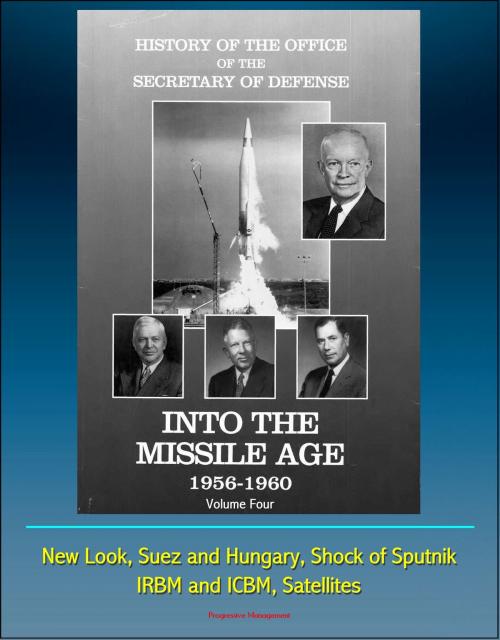History of the Office of the Secretary of Defense, Volume Four, Into the Missile Age 1956-1960: New Look, Suez and Hungary, Shock of Sputnik, IRBM and ICBM, Satellites
Nonfiction, History, Military, Aviation, United States| Author: | Progressive Management | ISBN: | 9781301961498 |
| Publisher: | Progressive Management | Publication: | July 13, 2013 |
| Imprint: | Smashwords Edition | Language: | English |
| Author: | Progressive Management |
| ISBN: | 9781301961498 |
| Publisher: | Progressive Management |
| Publication: | July 13, 2013 |
| Imprint: | Smashwords Edition |
| Language: | English |
The series of volumes on the History of the Office of the Secretary of Defense constitutes a history of national security policy focusing on the role of the secretary of defense and OSD written from the records of the highest levels of the U. S. Government. The range of the volume for the period August 1956-January 1961 is extensive. These were years of great international challenges and enormous technological change that profoundly affected the making of national security policy. The instability of the world manifested itself in all parts of the globe. The secretary of defense confronted crises in the Middle East —Suez in 1956 and Lebanon in 1958—and in the Far East—the Taiwan Strait in 1958 and the worsening situation in Indochina. In Europe the Hungarian revolution in 1956 and the Berlin crisis of 1958-61 exacerbated tensions between the United States and the Soviet Union. Closer to home, the emergence of Fidel Castro's Cuba as a Soviet ally portended a future crisis with which the next administration would have to deal. The rising tide of anti-colonialism, particularly in Africa, affected relations with allies as well. Alliance relationships—especially with NATO—and arms control efforts required much time and attention from the Department of Defense. Military assistance to allies and other countries remained a key element in U.S. policy. The volume emphasizes the centrality of the budget in national security policy considerations. Other influences—particularly the fast-moving technological revolution in weapons—played a significant role. Developments in nuclear weapons and missiles of ever-increasing range and potency exercised a powerful effect on all aspects of planning and programming and quickened the arms race with the Soviet Union. During these years continental defense and the organization and direction of strategic forces presented major issues requiring decisions that had long-term effects. Finally, there occurred a major reorganization of the Department of Defense in 1958 that established the basic shape of the department for most of the next three decades.
Close of Wilson Era, 1956-1957 * Defense as an Issue in 1956 Election * 1956 Crises: Suez and Hungary * Middle East in 1956 * Egypt and Suez Canal * Diplomacy in Action * Eastern Europe Boils Over * Attack on Egypt * Suez War Ends * Picking Up Pieces * Eisenhower Doctrine * Aftermath in Hungary * IV. Budget for FY 1958 * Early Budget Estimates * Getting Down to Reality * Public Presentation of Budget * Controversy over National Guard * Economy Push in Congress * Problem of Rising Expenditures * Congress Acts on Budget * Military Program Reexamined * Final Congressional Action * Budget in Retrospect * V. Policy Under Review, 1957 * Military Issues in Policy Discussion * NSC 5707/8 * Strategy in Public Eye: "Limited War" Debate * JSOP-61 and Budget * Cordiner Committee * Budget Guidelines for FY 1959 * Crisis at Little Rock * Shock of Sputnik * VI. FY 1959 Budget: Final * Change of Command at Pentagon * Immediate Response to Sputnik * Gair Report * FY 1959 Budget Takes Shape * Mind of Congress * FY 1959 Supplemental Request * Final Legislative Package * Aftermath * VII. Missile Problems and Progress, 1956-1958 * Arrival of Missile Age * Rise of IRBMs: Thor, Jupiter, Polaris * Deployment Planning * Army Tactical Missiles * Or Missile Programs * Satellite Programs * Missile Programs Reviewed * Initial Effects of Sputnik * Impact of Gair Report * Advanced Research Projects Agency * Furr Acceleration of Effort * National Aeronautics and Space Administration * VIII. Foreign Crises in 1958: Lebanon and Taiwan * Implications of Eisenhower Doctrine * Developments in 1958 * Intervention in Lebanon * Lebanon Pacified * Taiwan Situation * Threat to Offshore Islands * Artillery Blockade * Communist China Backs Down * Aftermath
The series of volumes on the History of the Office of the Secretary of Defense constitutes a history of national security policy focusing on the role of the secretary of defense and OSD written from the records of the highest levels of the U. S. Government. The range of the volume for the period August 1956-January 1961 is extensive. These were years of great international challenges and enormous technological change that profoundly affected the making of national security policy. The instability of the world manifested itself in all parts of the globe. The secretary of defense confronted crises in the Middle East —Suez in 1956 and Lebanon in 1958—and in the Far East—the Taiwan Strait in 1958 and the worsening situation in Indochina. In Europe the Hungarian revolution in 1956 and the Berlin crisis of 1958-61 exacerbated tensions between the United States and the Soviet Union. Closer to home, the emergence of Fidel Castro's Cuba as a Soviet ally portended a future crisis with which the next administration would have to deal. The rising tide of anti-colonialism, particularly in Africa, affected relations with allies as well. Alliance relationships—especially with NATO—and arms control efforts required much time and attention from the Department of Defense. Military assistance to allies and other countries remained a key element in U.S. policy. The volume emphasizes the centrality of the budget in national security policy considerations. Other influences—particularly the fast-moving technological revolution in weapons—played a significant role. Developments in nuclear weapons and missiles of ever-increasing range and potency exercised a powerful effect on all aspects of planning and programming and quickened the arms race with the Soviet Union. During these years continental defense and the organization and direction of strategic forces presented major issues requiring decisions that had long-term effects. Finally, there occurred a major reorganization of the Department of Defense in 1958 that established the basic shape of the department for most of the next three decades.
Close of Wilson Era, 1956-1957 * Defense as an Issue in 1956 Election * 1956 Crises: Suez and Hungary * Middle East in 1956 * Egypt and Suez Canal * Diplomacy in Action * Eastern Europe Boils Over * Attack on Egypt * Suez War Ends * Picking Up Pieces * Eisenhower Doctrine * Aftermath in Hungary * IV. Budget for FY 1958 * Early Budget Estimates * Getting Down to Reality * Public Presentation of Budget * Controversy over National Guard * Economy Push in Congress * Problem of Rising Expenditures * Congress Acts on Budget * Military Program Reexamined * Final Congressional Action * Budget in Retrospect * V. Policy Under Review, 1957 * Military Issues in Policy Discussion * NSC 5707/8 * Strategy in Public Eye: "Limited War" Debate * JSOP-61 and Budget * Cordiner Committee * Budget Guidelines for FY 1959 * Crisis at Little Rock * Shock of Sputnik * VI. FY 1959 Budget: Final * Change of Command at Pentagon * Immediate Response to Sputnik * Gair Report * FY 1959 Budget Takes Shape * Mind of Congress * FY 1959 Supplemental Request * Final Legislative Package * Aftermath * VII. Missile Problems and Progress, 1956-1958 * Arrival of Missile Age * Rise of IRBMs: Thor, Jupiter, Polaris * Deployment Planning * Army Tactical Missiles * Or Missile Programs * Satellite Programs * Missile Programs Reviewed * Initial Effects of Sputnik * Impact of Gair Report * Advanced Research Projects Agency * Furr Acceleration of Effort * National Aeronautics and Space Administration * VIII. Foreign Crises in 1958: Lebanon and Taiwan * Implications of Eisenhower Doctrine * Developments in 1958 * Intervention in Lebanon * Lebanon Pacified * Taiwan Situation * Threat to Offshore Islands * Artillery Blockade * Communist China Backs Down * Aftermath















